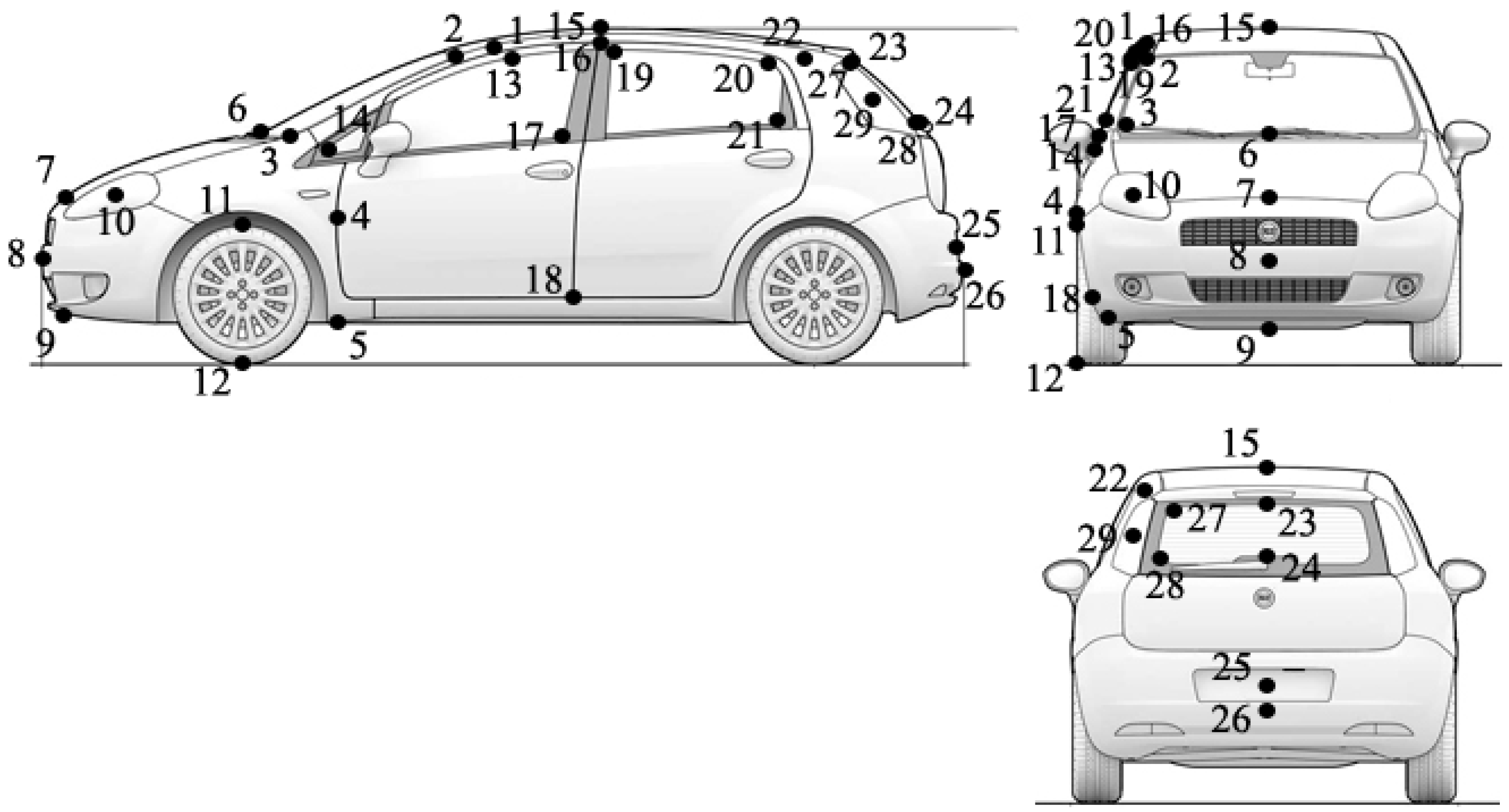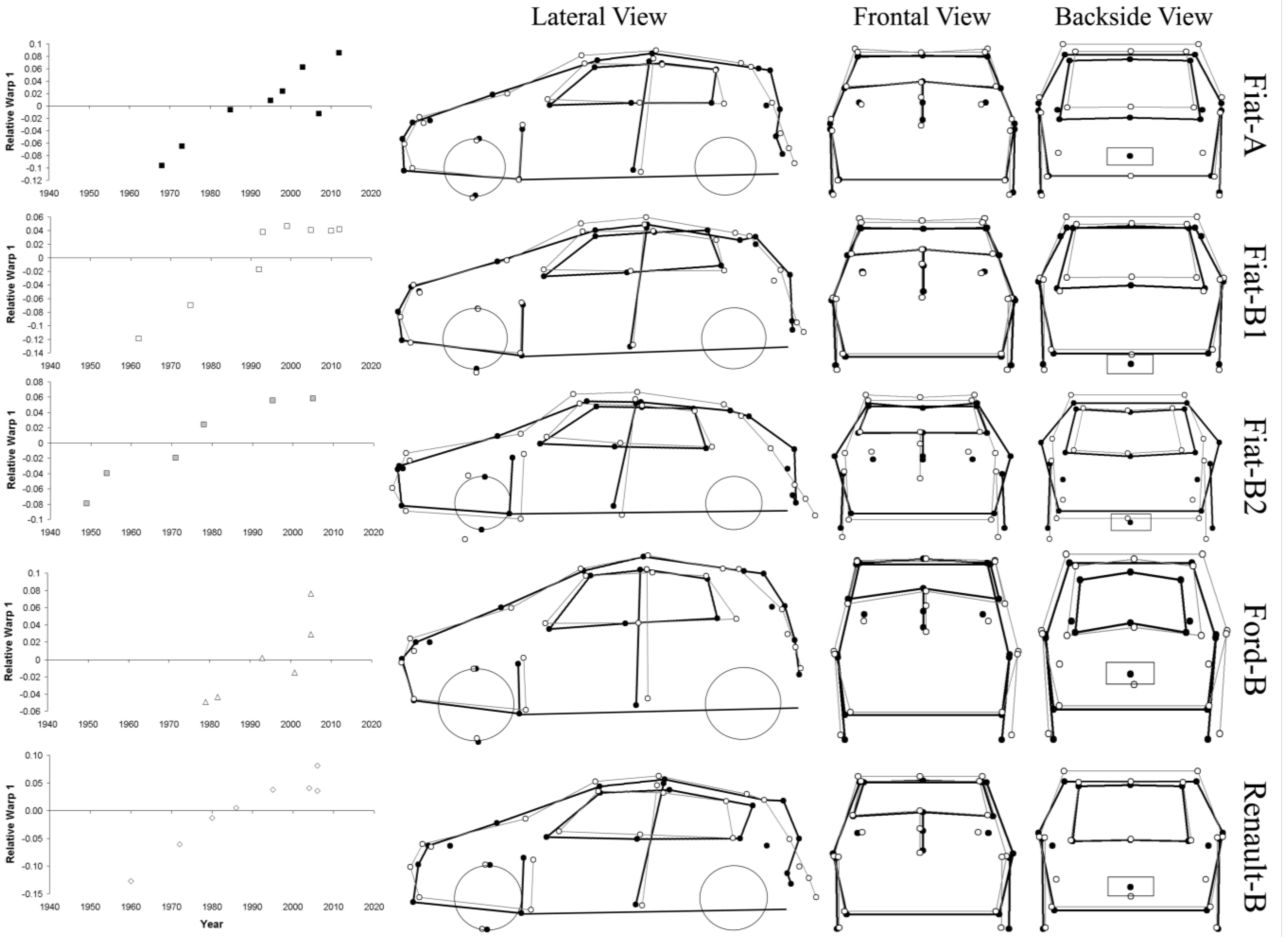Temporal Shape Changes and Future Trends in European Automotive Design
Abstract
:1. Introduction
2. Experimental Section
2.1. Data Sources
| Brand | Segment | Model | Year | Brand | Segment | Model | Year |
|---|---|---|---|---|---|---|---|
| Fiat | A | Nuova 500 | 1968 | Ford | A | Ka | 1998 |
| 126 | 1973 | B | Fiesta | 1979 | |||
| Panda | 1985 | Fiesta | 1982 | ||||
| Cinquecento | 1995 | Fiesta | 1993 | ||||
| Seicento | 1998 | Fiesta | 2001 | ||||
| Panda | 2003 | Fiesta | 2005 | ||||
| 500 | 2007 | Fusion | 2005 | ||||
| Panda | 2012 | Renault | A | 4cv | 1957 | ||
| B1 | 600 | 1962 | 4 | 1979 | |||
| Uno | 1992 | Twingo Mk1 | 2000 | ||||
| Punto | 1993 | Twingo Mk2 | 2012 | ||||
| 127 | 1995 | B | Dauphine | 1960 | |||
| Punto | 1999 | 6 | 1972 | ||||
| Grande Punto | 2005 | 5 | 1980 | ||||
| Punto Evo | 2010 | Supercinque | 1986 | ||||
| Punto | 2012 | Clio | 1995 | ||||
| B2 | 1100 | 1949 | Clio II | 2004 | |||
| 1100 | 1954 | Clio III | 2006 | ||||
| 128 | 1971 | Modus | 2006 | ||||
| Ritmo | 1978 | Volkswagen | A | Fox | 2006 | ||
| Brava | 1995 | Up | 2011 | ||||
| Stilo | 2005 | B | Polo III | 2006 |
2.2. Shape Analyses

3. Results and Discussion



4. Conclusions
Acknowledgments
Author Contributions
Conflicts of Interest
References
- Grimson, W.M.; Murphy, M. An evolutionary perspective on engineering design. In Engineering in Context; Christensen, S., Delahousse, B., Meganck, M., Eds.; Aarhus Academica: San Francisco, CA, USA, 2009; pp. 263–276. [Google Scholar]
- Darwin, C. On the Origin of Species by Means of Natural Selection; John Murray Publisher: London, UK, 1859. [Google Scholar]
- Galor, O.; Moav, O. Natural selection and the origin of economic growth. Q. J. Econ. 2002, 117, 1133–1191. [Google Scholar] [CrossRef]
- Gautschi, D.A.; Sabavala, D.J. The world that changed the machines: A marketing perspective on the early evolution of automobiles and telephony. Technol. Soc. 1995, 17, 55–84. [Google Scholar] [CrossRef]
- Blume, L.E.; Easley, D. Optimality and natural selection in markets. J. Econ. Theory 2002, 107, 95–135. [Google Scholar] [CrossRef]
- Reznick, D.; Nunney, L.; Tessier, A. Big houses, big cars, superfleas and the costs of reproduction. Trends Ecol. Evol. 2000, 15, 421–425. [Google Scholar] [CrossRef]
- Buenstrof, G. How useful is generalized Darwinism as a framework to study competition and industrial evolution? J. Evol. Econ. 2006, 16, 511–527. [Google Scholar] [CrossRef]
- Chandrasegaran, S.K.; Ramani, K.; Sriram, R.D.; Horváth, I.; Bernard, A.; Harik, R.F.; Gao, W. The evolution, challenges, and future of knowledge representation in product design systems. CAD Comput. Aided Des. 2013, 45, 204–228. [Google Scholar] [CrossRef]
- Erk, S.; Manfred, S.; Wunderlich, A.P.; Galley, L.; Henrik, W. Cultural objects modulate reward circuitry. Neuroreport 2002, 13, 2499–2503. [Google Scholar] [CrossRef] [PubMed]
- Hardy, S. A cycle of dependence. Automobiles, accessibility and the evolution of the transportation and retail hierarchies. Berkeley Plan J. 1993, 8, 21–43. [Google Scholar]
- Dijk, M.; Yarime, M. The emergence of hybrid-electric cars: Innovation path creation through co-evolution of supply and demand. Technol. Forecast. Soc. Chang. 2010, 77, 1371–1390. [Google Scholar] [CrossRef]
- Aguzzi, J.; Costa, C.; Antonucci, F.; Company, J.B.; Menesatti, P.; Sardá, F. Influence of rhythmic behaviour in the morphology of Decapod Natantia. Biol. J. Linnenan Soc. 2008, 96, 517–532. [Google Scholar] [CrossRef]
- Antonucci, F.; Costa, C.; Aguzzi, J.; Cataudella, S. Ecomorphology of morpho-functional relationships in the family of Sparidae: A quantitative statistic approach. J. Morphol. 2009, 270, 843–855. [Google Scholar] [CrossRef] [PubMed]
- Klingenberg, C.P. Morphometrics and the role of the phenotype in studies of the evolution of developmental mechanisms. Gene 2002, 287, 3–10. [Google Scholar] [CrossRef]
- Mitteroecker, P.; Gunz, P. Advances in Geometric Morphometrics. Evol. Biol. 2009, 36, 235–247. [Google Scholar] [CrossRef]
- Lawing, A.M.; Polly, P.D. Geometric morphometrics: recent applications to the study of evolution and development. J. Zool. 2010, 280, 1–7. [Google Scholar] [CrossRef]
- Warisawa, S. Study on European market-oriented passenger car design based on quantitative representation of shape characteristics. J. Mach. Eng. 2011, 11, 111–125. [Google Scholar]
- Windhager, S.; Slice, D.E.; Schaefer, K.; Oberzauche, E.; Thorstensen, T.; Grammer, K. Face to face: The perception of automotive designs. Hum. Nat. 2008, 19, 331–346. [Google Scholar] [CrossRef] [PubMed]
- Windhager, S.; Bookstein, F.L.; Grammer, K.; Oberzaucher, E.; Said, H.; Slice, D.E.; Thorstensen, T.; Schaefer, K. “Cars have their own faces”: Cross-Cultural ratings of car shapes in biological (stereotypical) terms. Evol. Hum. Behav. 2012, 33, 109–120. [Google Scholar] [CrossRef]
- Zelditch, M.L.; Swiderki, D.L.; Sheets, H.D.; Fink, W.L. Geometric Morphometrics for Biologists: A Primer; Academic Press: San Diego, CA, USA, 2004. [Google Scholar]
- Costa, C.; Antonucci, F.; Pallottino, F.; Aguzzi, J.; Sun, D.W.; Menesatti, P. Shape analysis of agricultural products: A review of recent research advances and potential application to computer vision. Food Bioprocess Technol. 2011, 4, 673–692. [Google Scholar] [CrossRef]
- Bookstein, F.L. Morphometric Tool for Landmark Data; Cambridge University Press: Cambridge, MA, USA, 1991. [Google Scholar]
- Rohlf, F.J. tpsDig, Digitize Landmarks and Outlines, version 2.05; Department of Ecology and Evolution Stony Brook (State University) Press: New York, NY, USA, 2005. [Google Scholar]
- Menesatti, P.; Angelini, C.; Pallottino, F.; Antonucci, F.; Aguzzi, J.; Costa, C. RGB color calibration for quantitative image analysis: The “3D Thin-Plate Spline” warping approach. Sensors 2012, 12, 7063–7079. [Google Scholar] [CrossRef] [PubMed]
- Rohlf, F.J; Marcus, L.F. A revolution in morphometry. Trends Ecol. Evol. 1993, 8, 129–132. [Google Scholar] [CrossRef]
- Antonucci, F.; Boglione, C.; Cerasari, V.; Caccia, E.; Costa, C. External shape analyses in Atherina boyeri (Risso, 1810) from different environments. Ital. J. Zool. 2012, 79, 60–68. [Google Scholar] [CrossRef] [Green Version]
- Aguzzi, J.; Costa, C.; Ketmaier, V.; Angelini, C.; Antonucci, F.; Menesatti, P.; Company, J.B. Light-dependent genetic and phenotypic differences in the squat lobster Munida tenuimana (Crustacea: Decapoda) along deep continental margin. Progress Oceanogr. 2013, 118, 199–209. [Google Scholar] [CrossRef]
- Seller, M. Automotive emotions: Feeling the car. Theory Cult. Soc 2004, 21, 221–242. [Google Scholar] [CrossRef]
- Marcus, L.F. Traditional morphometrics. In Proceedings of the Michigan Morphometric Workshop; Special Publication No. 2. Rohlf, F.J., Bookstein, F.L., Eds.; The University of Michigan Museum of Zoology: Ann Arbor, MI, USA, 1990; pp. 77–122. [Google Scholar]
- Ziman, J. Marriage of design and selection in the evolution of cultural artefacts. Interdiscip. Sci. Rev. 1999, 24, 139–154. [Google Scholar] [CrossRef]
- Schluter, D.; Clifford, E.A.; Nemethy, M.; McKinnon, L.S. Parallel evolution and inheritance of quantitative traits. Am. Nat. 2004, 163, 808–822. [Google Scholar] [CrossRef] [PubMed]
- Ochman, H.; Lawrence, J.G.; Groisman, E.A. Lateral gene transfer and the nature of bacterial innovation. Nature 2000, 405, 299–304. [Google Scholar] [CrossRef] [PubMed]
- Keeling, P.J.; Palmer, J.D. Horizontal gene transfer in eukaryotic evolution. Nat. Rev. Genet. 2008, 9, 605–618. [Google Scholar] [CrossRef] [PubMed]
- Fisher, M.; Ramdas, K.; Ulrich, K. Component sharing in the management of product variety: A study of automotive braking systems. Manag. Sci. 1999, 45, 297–315. [Google Scholar] [CrossRef]
- French, M. Invention and Evolution: Design in Nature and Engineering, 2nd ed.; Cambridge University Press: Cambridge, MA, USA, 1994. [Google Scholar]
- Geroski, P. The Evolution of New Markets; Oxford University Press: Oxford, MI, USA, 2003. [Google Scholar]
- Grether, G.F.; Losin, N.; Anderson, C.N.; Okamoto, K. The role of interspecific interference competition in character displacement and the evolution of competitor recognition. Biol. Rev. 2009, 84, 617–635. [Google Scholar] [CrossRef] [PubMed]
- Metcalfe, J.S. Evolutionary Economics and Creative Distrution; The Graz Shumpeter Lectures, Reoutledge: Graz, Austria, 1998. [Google Scholar]
- Lo, A.W. The adaptive markets hypothesis: Market efficiency from an evolutionary perspective. J. Portf. Manag. 2004, 30, 15–29. [Google Scholar] [CrossRef]
- O’Higgins, P.; Cobb, S.N.; Fitton, L.C.; Groning, F.; Phillips, R.; Liu, J.; Fagan, M.J. Combining geometric morphometrics and functional simulation: An emerging toolkit for virtual functional analyses. J. Anat. 2010, 218, 3–15. [Google Scholar] [CrossRef] [PubMed]
© 2015 by the authors; licensee MDPI, Basel, Switzerland. This article is an open access article distributed under the terms and conditions of the Creative Commons Attribution license (http://creativecommons.org/licenses/by/4.0/).
Share and Cite
Costa, C.; Aguzzi, J. Temporal Shape Changes and Future Trends in European Automotive Design. Machines 2015, 3, 256-267. https://doi.org/10.3390/machines3030256
Costa C, Aguzzi J. Temporal Shape Changes and Future Trends in European Automotive Design. Machines. 2015; 3(3):256-267. https://doi.org/10.3390/machines3030256
Chicago/Turabian StyleCosta, Corrado, and Jacopo Aguzzi. 2015. "Temporal Shape Changes and Future Trends in European Automotive Design" Machines 3, no. 3: 256-267. https://doi.org/10.3390/machines3030256





